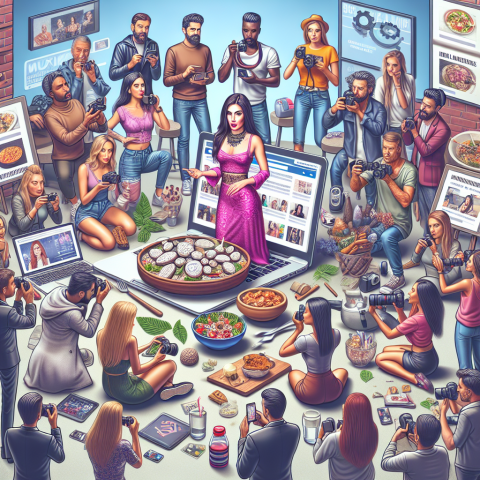Influencer Marketing – Okay, I’ve got to admit it: when influencer marketing first started blowing up, I wasn’t fully convinced. I mean, all these people with millions of followers pushing products? It felt a little… off to me. But, over the years, I’ve seen firsthand how much it’s changed the marketing landscape—and it’s clear now that influencer marketing is only going to keep growing. By 2025, it’s poised to completely dominate the business world. Let me tell you why.

Why Influencer Marketing Will Dominate Business in 2025
The Power of Trust and Authenticity
Here’s the thing—people trust people more than they trust brands. If you were like me and thought a brand could just throw an ad up on TV or social media and expect people to buy, it’s time to rethink that strategy. Influencers, especially those with smaller, niche followings, are trusted. Their followers genuinely believe in what they recommend because it feels real. When they post about a product they love, it doesn’t feel like a pitch. It feels like a friend telling you about something awesome.
Take it from me, I’ve bought plenty of things based on influencer recommendations that I probably wouldn’t have considered otherwise. I remember buying a skincare product last year after seeing an influencer talk about it on their Instagram story. I wasn’t even particularly looking for new skincare, but her personal recommendation made me take the plunge. And guess what? I loved it. That’s the magic of influencer marketing—it’s not just an ad; it’s word-of-mouth in a modern form.
Now, as consumers get savvier, the need for authenticity in marketing becomes even more critical. Brands can’t just throw money at celebrities anymore and expect results. They need influencers who genuinely connect with their audience, who create content that feels natural and aligned with their personal brand. This is exactly why influencer marketing is going to dominate—it’s about building relationships, not just making sales.
Highly Targeted Marketing
One of the best parts about influencer marketing is the targeting. Think about it—TV ads or billboards can’t really target specific groups. You can’t control who sees it. But with influencers, you get to reach highly engaged audiences who want to hear from you.
Let me give you an example. If you’re running a vegan snack company, you’re not going to want to advertise on a sports network, right? Instead, you can partner with vegan food influencers who have built communities of people who care about what they eat. That’s a laser-targeted audience. I’ve worked with influencers on campaigns where the audience engagement was off the charts because we got the targeting just right. Their followers were already aligned with the brand, and the content felt super relevant.
This kind of precise targeting is something traditional advertising simply can’t match. The data available today allows businesses to pick influencers based on things like demographics, interests, and even behaviors. And this isn’t just about Instagram—don’t sleep on TikTok, YouTube, or podcasts. These platforms give brands access to even more hyper-targeted audiences.
Cost-Effective Marketing for Small Businesses
Now, let’s talk about one of the reasons why influencer marketing will dominate by 2025—cost-effectiveness. For a small business, TV ads or large-scale print campaigns are out of the question. But influencer marketing? That’s where things get interesting. You don’t need to partner with huge stars to see results. Micro-influencers—those with smaller but incredibly engaged followings—can drive massive results for a fraction of the cost.
I’ve worked with influencers who have only a few thousand followers, but their engagement is crazy high. These influencers aren’t charging the big bucks like celebrities, but they still provide a solid return on investment. Small businesses can collaborate with influencers in their niche and reach people who are already interested in their product. It’s a win-win.
And it’s not just for small businesses—big companies are starting to see the value in working with influencers who have a smaller following but a much more loyal audience. It’s like that saying, “Don’t judge a book by its cover.” You might think a micro-influencer can’t move the needle, but in reality, their highly engaged followers trust them more, and that trust leads to more conversions.
The Shift to Video Content
Let’s face it, video is everything these days. TikTok, YouTube, Instagram Stories—these platforms have made video content more accessible than ever. As someone who spends way too much time scrolling through TikTok, I can tell you that video is where the magic happens. Influencers are great at creating short, engaging videos that not only showcase a product but also tell a story around it. And that’s what consumers want: stories.
I’ve seen some incredible influencer videos where they creatively showcase products in a way that feels organic and fun. One influencer I follow did a hilarious, yet effective, video on a home cleaning product. She wasn’t just talking about how it worked; she was making it part of her daily routine. It felt so relatable—and guess what? I ended up buying it.
This shift to video is only going to grow in 2025. As more people consume content through video, influencer marketing will evolve to meet this demand. If you’re not already incorporating video into your influencer campaigns, you’re missing out. Whether it’s Instagram Reels, TikTok trends, or YouTube vlogs, video is going to be the go-to content format for influencer collaborations.
Social Media Platforms Are Becoming E-Commerce Hubs
Here’s something I didn’t see coming but definitely should have—social media platforms are becoming full-blown shopping destinations. Instagram, Facebook, and TikTok now let you buy products directly through their platforms. And guess what? Influencers are at the center of it all. These platforms are integrating “shop now” buttons into their posts, making it easier than ever for consumers to go from discovering a product to making a purchase—all while watching their favorite influencer’s content.
I’ve been guilty of clicking that “shop now” button after seeing something I liked on an influencer’s post. And I’m not the only one. In fact, 70% of consumers say they’ve bought something they saw on Instagram, according to a survey by BigCommerce. The lines between content, entertainment, and shopping are becoming increasingly blurred, and influencers are the perfect bridge between the two.
The Data-Driven Future of Influencer Marketing
By 2025, the role of data and analytics in influencer marketing will be even more crucial. Brands will have access to more detailed metrics about the effectiveness of influencer campaigns. From impressions and engagement rates to the real impact on sales, data will drive decisions. Influencer marketing will be just as measurable as any other type of digital marketing, and companies will be able to refine their strategies accordingly.
I’ve seen influencer campaigns where the numbers spoke for themselves. We could track conversions, see which posts performed best, and adjust our strategy in real-time. The ability to constantly analyze and optimize campaigns is a big reason why influencer marketing will continue to grow and dominate in 2025.
The Bottom Line: Influencer Marketing Isn’t Going Anywhere
Looking ahead to 2025, it’s clear that influencer marketing will continue to dominate the business landscape. It’s not just a trend; it’s a shift in how businesses and consumers interact. As brands continue to embrace the authenticity, targeted reach, and cost-effectiveness that influencers bring, this form of marketing is only going to get bigger and more impactful.
If you’re a business owner and haven’t started incorporating influencer marketing into your strategy, now’s the time to dive in. Start small, partner with micro-influencers, and focus on building relationships that are authentic and genuine. You’ll be ahead of the game, and by 2025, you’ll be reaping the rewards of a strategy that’s truly built for the future.





